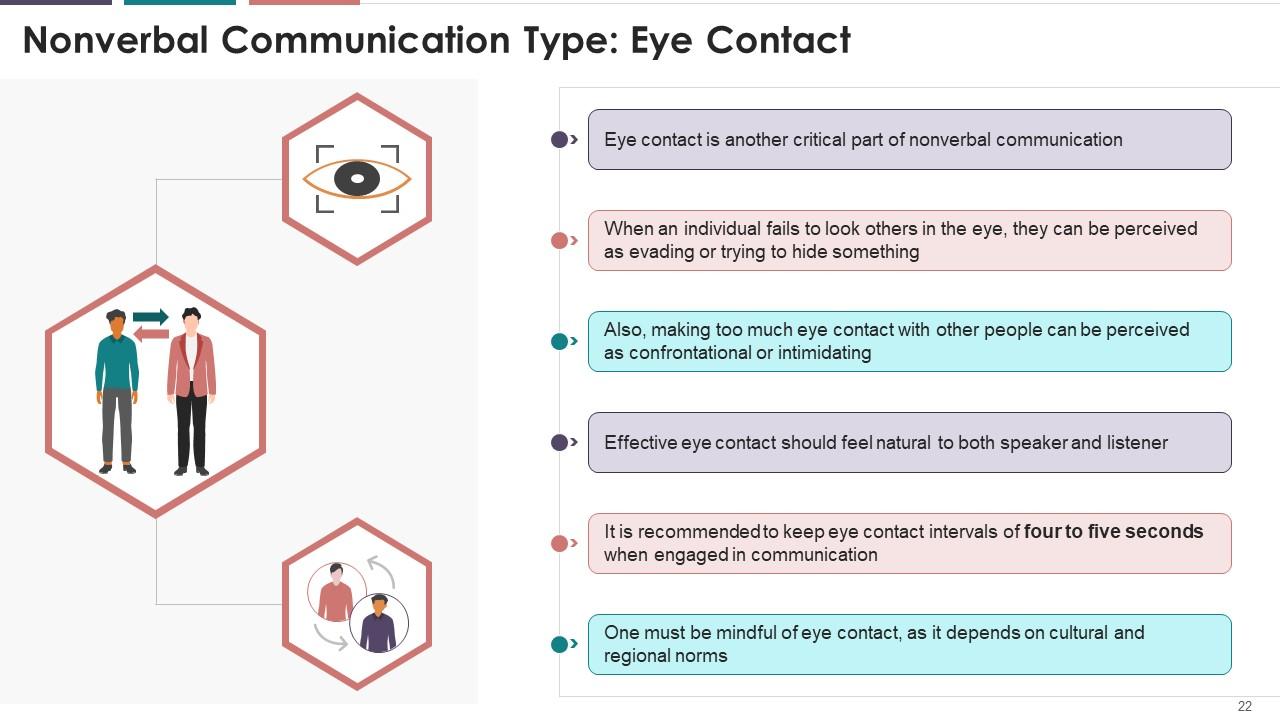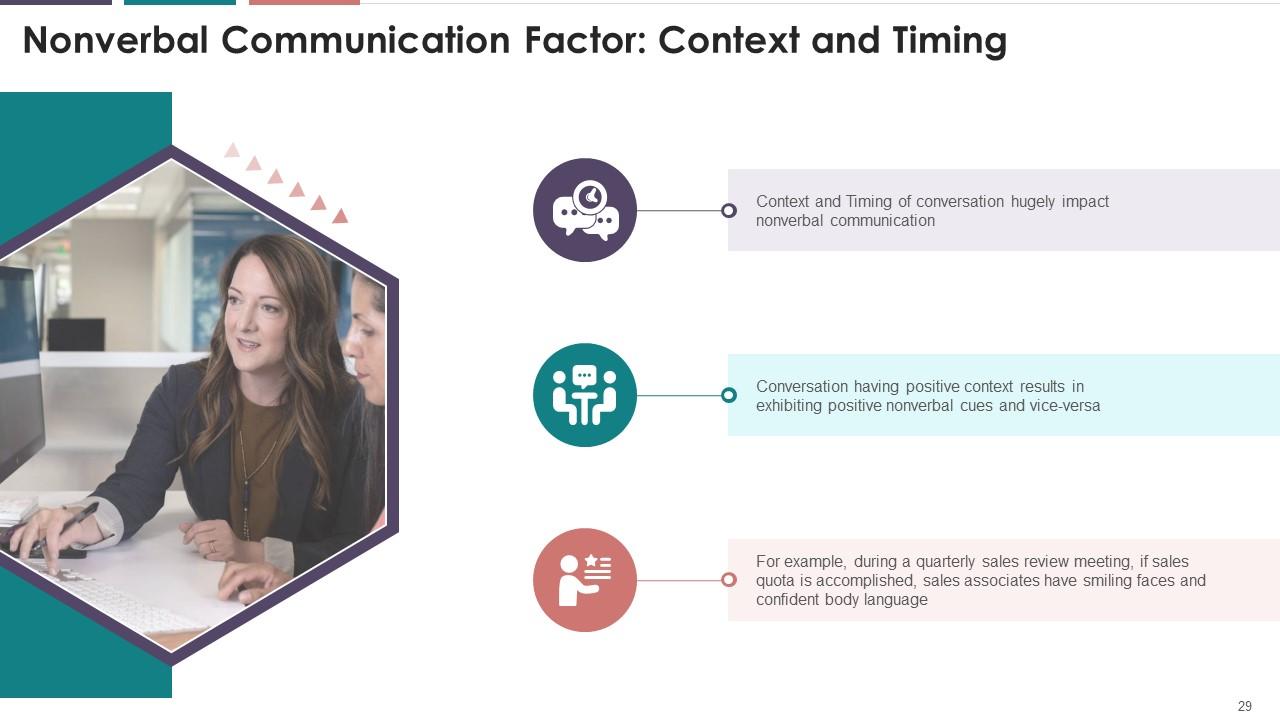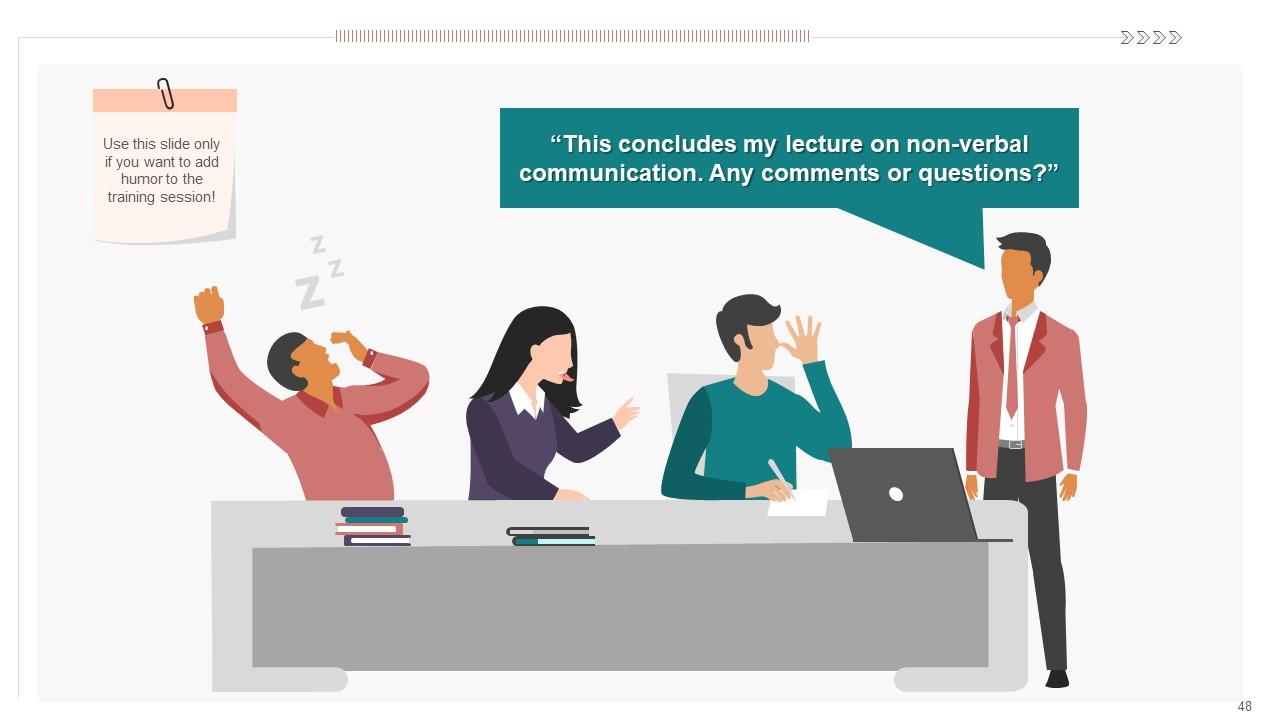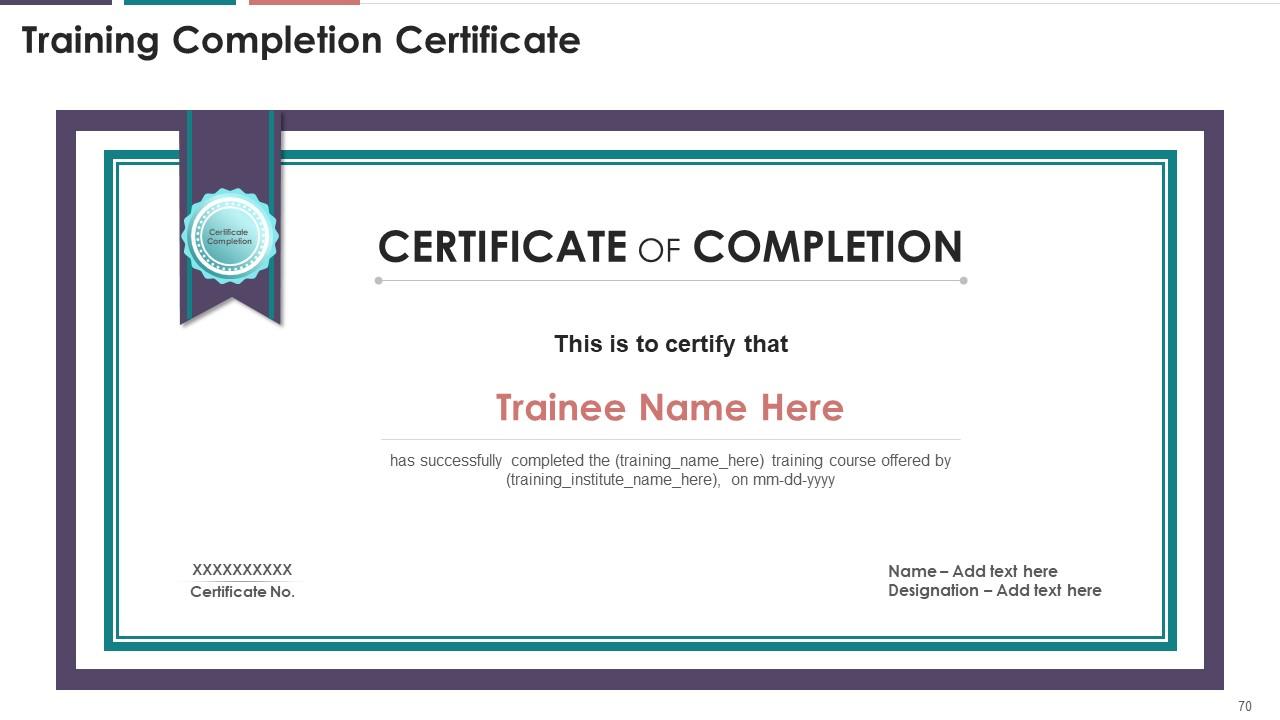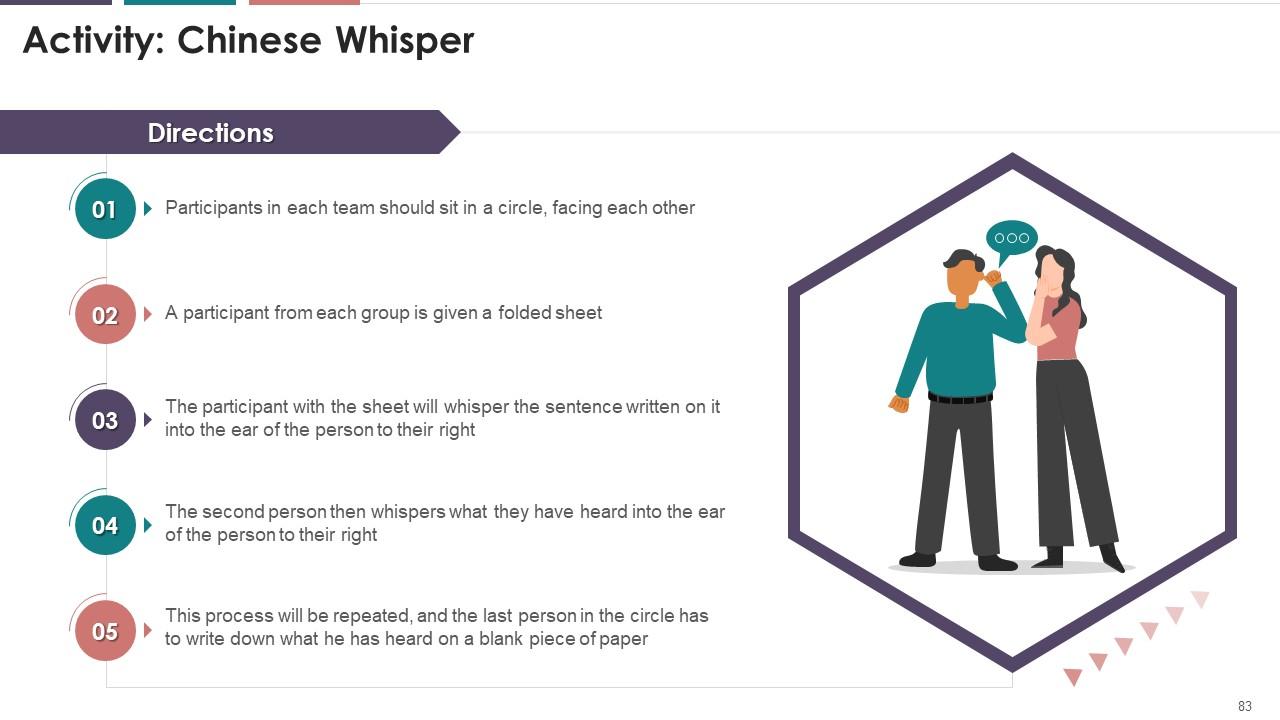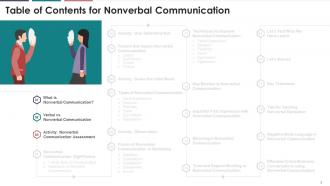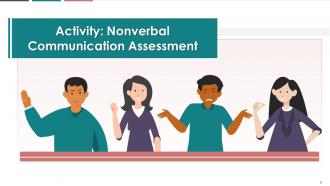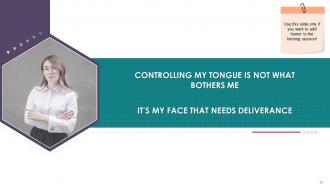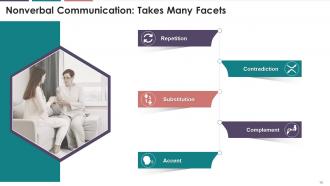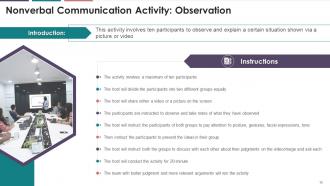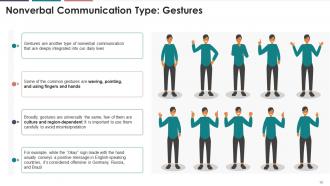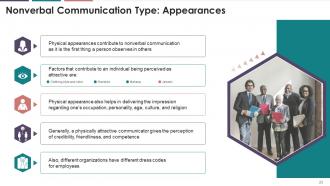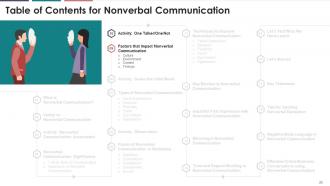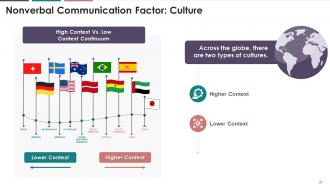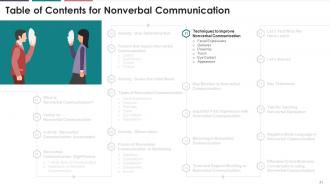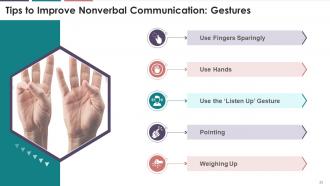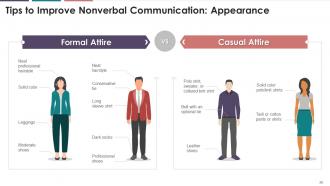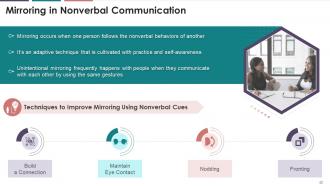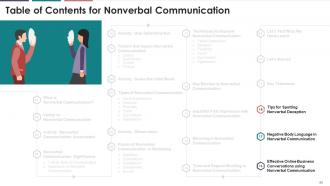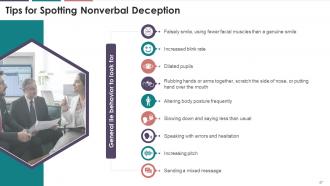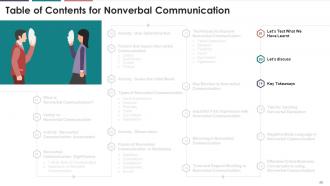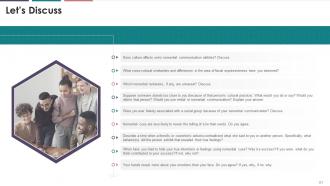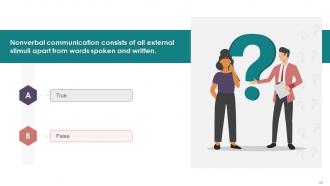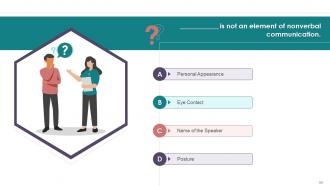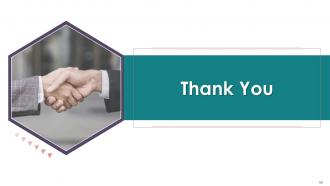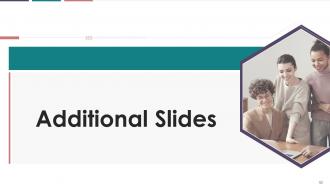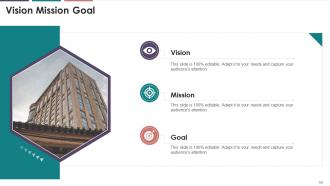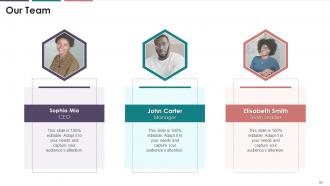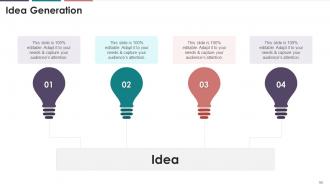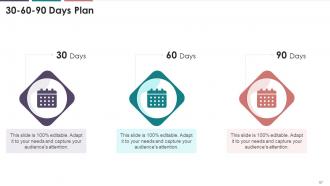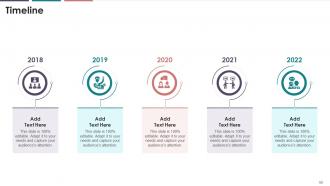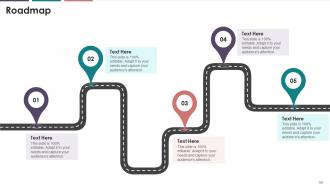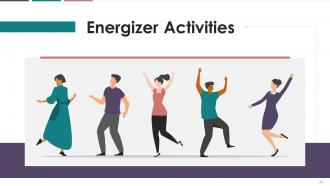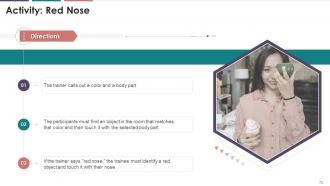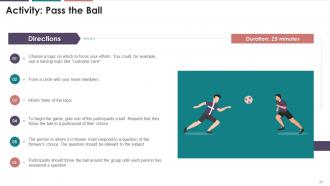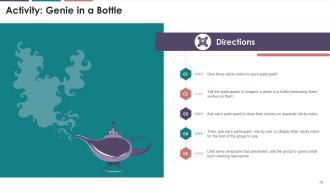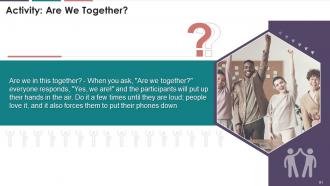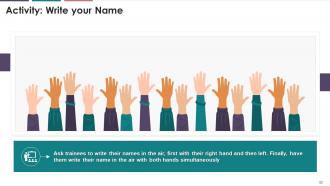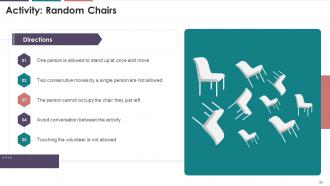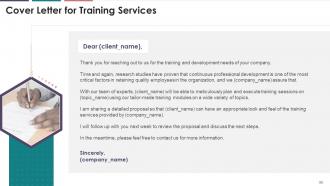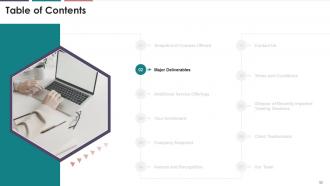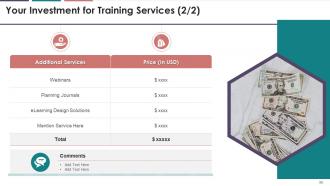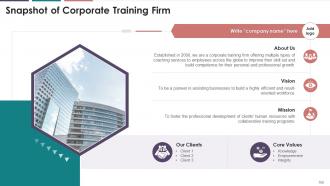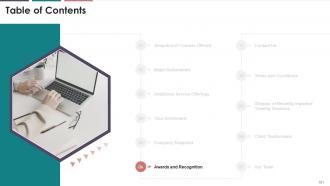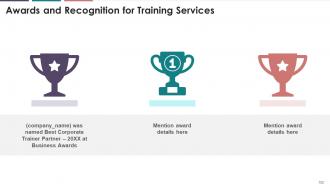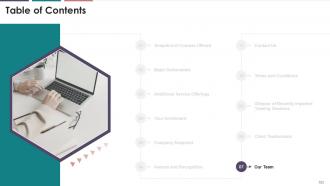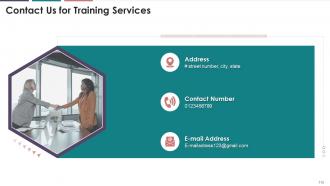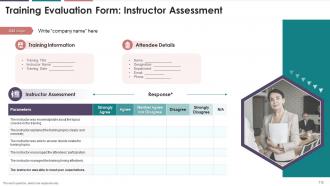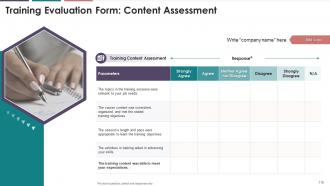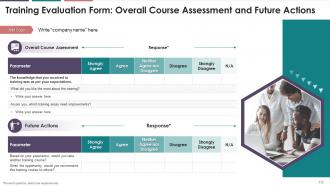Nonverbal Communication Training Module On Business Communication Edu Ppt
This PowerPoint training deck covers the concept of Nonverbal Communication. It includes significance and factors that impact nonverbal communication along with its types, such as facial expressions, gestures, proximity, touch, eye contact, and appearance. The PPT module also contains techniques to develop nonverbal communication effectively, key barriers to nonverbal communication, and tips for spotting nonverbal deception. Further, it covers mirroring, rapport building, and effective online business conversations using nonverbal communication. The PowerPoint deck also contains key takeaways, case studies, activities, discussion questions, MCQs, and memes to make the training session interactive. It also includes additional slides on about us, vision, mission, goal, 30-60-90 days plan, timeline, roadmap, training completion certificate, energizer activities, detailed client proposal, and training assessment form.
You must be logged in to download this presentation.
 Impress your
Impress your audience
Editable
of Time
PowerPoint presentation slides
Presenting Training Module on Nonverbal Communication. This deck contains 117 uniquely designed slides. Our PowerPoint experts have included all the necessary templates, designs, icons, graphs and other essential material. This deck is well crafted by extensive research. Slides consists of amazing visuals and appropriate content. These PPT slides can be instantly downloaded with just a click. Compatible with all screen types and monitors. Supports Google Slides. Premium Customer Support available. Suitable for use by managers, employees and organizations. These slides are easily customizable. You can edit the color, text, icon and font size to suit your requirement.
People who downloaded this PowerPoint presentation also viewed the following :
Content of this Powerpoint Presentation
Slide 4
This slide provides information regarding the
definition of nonverbal communication.
Slide 5
This slide illustrates the key difference between
verbal and nonverbal communication. The multiple comparison factors used to
differentiate are the usage of words, ease of understanding, structure,
information distortion, feedback, documentary evidence, and physical presence.
Slide 6
This slide showcases the activity for nonverbal
training. It also contains the questions to ask in nonverbal communication
training session.
Slide 7
Instructor’s Notes:
·
Ask trainees to answer the questions in
each section as per their comfort level
·
Guide them to answer the questions honestly
without overthinking as there are no right or wrong answers
·
Once answered, ask them to calculate the
score
·
If any question does not apply to them, ask
them to mark it as N/A
Slide 8
Instructor’s Notes:
·
Ask training attendees to answer the
questions in each section as per their comfort level
·
Guide them to answer the questions honestly
without overthinking as there are no right or wrong answers
·
Once answered, ask them to calculate the
score
·
If any question does not apply to them, ask
them to mark it as N/A
Slide 9
Instructor’s Notes:
·
Ask training attendees to answer the questions
in each section as per their comfort level
·
Guide them to answer the questions honestly
without overthinking as there are no right or wrong answers
·
Once answered, ask them to calculate the
score
·
If any question does not apply to them, ask
them to mark it as N/A
Slide 11
This slide highlights the 7-38-55 Mehrabian Formula of
communication indicating the significance of nonverbal communication.
Slide 12
This slide lists the significance of nonverbal
communication at the workplace, such as supporting verbal communication,
building trust and credibility, increasing workplace efficiency, overcoming
cultural barriers, and communicating with persons with hearing disabilities.
Instructor’s Notes:
Nonverbal communication is important due to following
reasons:
·
Supports Verbal Communication: Nonverbal
communication adds value to verbal communication with the use of gestures,
facial expressions, eye contact, and posture. All of this non-verbal
information when paired with the verbal communication adds punch and increases
the effectiveness of the message
·
Builds Trust And Credibility: Nonverbal
cues help gain trust and build credibility. In situations when the spoken word
cannot be verified or the written note analyzed, non-verbal cues are critical
·
Increases Workplace Efficiency: Positive
non-verbal cues boost employee satisfaction, resulting in decreased absenteeism
and enhanced workplace efficiency
·
Overcome Cultural Barriers: In
intercultural situations, nonverbal communication helps understand the
undercurrent of the conveyed message by going beyond the literal meanings the
spoken words
·
Communicate with Persons with Hearing
Disabilities: At workplace, nonverbal communication makes
it possible to communicate with employees having hearing disabilities
Slide 13
The purpose of this slide is to showcase a nonverbal
meme to add humor to the business communication session.
Slide 14
This slide provides a snapshot of multiple facets of
the nonverbal communication such as repetition, contradiction, substitution,
complement, and accent.
Instructor’s Notes:
The major roles played by nonverbal communication are
as follows:
·
Repetition: Nonverbal
communication helps strengthen the conveyed verbal message by repeating it
·
For example, when a person nods their head
while saying yes, it leads to repetition
·
Contradiction: Nonverbal
communication can reveal our actual feelings about a situation
·
For example, if a manager is asking an
employee to come to office on Saturdays regularly for faster project
completion. The employee may agree, but facial expressions may convey his
reluctance
·
Substitution: Nonverbal
cues can be used as a substitute for verbal communication in
stressful/challenging work situations
·
Complement: Nonverbal
signals can be used to complement the verbal message
·
For example, a manager's firm handshake
with an employee after promoting him/her signals confidence and firm belief in
the employee's ability
·
Accent: Nonverbal
cues, if used appropriately, can emphasize the key part of the message
·
For example, when motivating the workforce,
a leader pounds the lecture stand
Slide 15
This slide list down the directions for observation
activity for the training session. It also explains the instructions that are
essential for successful conduct of the activity.
Slide 17
This slide highlights the major types of nonverbal
communication such as facial expressions, gestures, proximity, touch, eye
contact and appearance.
Slide 18
The purpose of this slide is to provide information
regarding facial expression, a type of nonverbal communication. It also
visually showcases universal facial expressions of anger, happiness, surprise,
disgust, sadness, and fear.
Slide 19
This slide indicates the details of gestures as a type
of nonverbal communication. It also highlights the common gestures such as
waving, pointing, and using fingers and hands.
Slide 20
The purpose of this slide is to provide information
regarding proximity in nonverbal communication. It also includes information
regarding the four zones of proximity which are intimate, personal, social, and
public.
Slide 21
The purpose of this slide is to provide information
regarding touch in nonverbal communication. It also includes information
regarding the appropriate touch behavior such as a pat on the back, handshakes,
and a hug.
Slide 22
This slide provides an overview of the significance of
eye contact in nonverbal communication.
Slide 23
This slide highlights the role of physical appearance
in nonverbal business communication.
Slide 24
This slide list down the directions for guess the
initial mood activity for the training session. It also explains the
instructions that are essential for conducting the activity successfully.
Instructor’s Notes:
Observations:
·
This activity helps demonstrate an
essential point on how to understand the body language
·
As soon as we see a person, we scan their
body language to establish their mood
Slide 26
This slide list down the multiple factors that impact
nonverbal communication in an individual. The major factors are culture,
environment, time, and senses.
Slide 27
This slide provides information regarding the impact of
cultural differences on nonverbal communication. It also includes details regarding
the higher and lower context cultures.
Instructor’s Notes:
·
High Context countries
are: Japan/China/UAE/Brazil
·
Individuals from such countries use
nonverbal cues to relay meanings in the conversation
·
Low Context countries
are: USA, Australia, and most European countries
·
Individuals from such countries prefer
verbal communication over nonverbal communication
·
Some examples of nonverbal communication in
context with specific cultural differences are as follows:
·
Facial Expressions: Facial
expression smiling is deemed
·
Acceptable and friendly in
low context cultures such as USA/Canada
·
Weakness
in Russia
·
Physical Space: In the USA, people prefer
to have more physical distance between the person they are conversing with,
while Arabs would often come close to better interact with their counterparts
·
Eye Contact: Long
eye contact in Asia might seem intimidating and offensive, while it shows
sincerity in the Americas and Europe
Slide 28
This slide highlights the impact of environment on nonverbal
communication. It also includes details regarding multiple environmental
factors such as atmosphere and scent.
Instructor’s Notes:
The key constituents of the environment that impact
nonverbal communication are as follows:
·
Atmosphere: The
temperature, lighting, color, and sound all impact human nonverbal behavior
·
For example, replacing a square table with
a circular one in the training room increases participants' interaction
·
Scent: The
fragrance of an environment is an essential factor in predicting how people
will behave as it triggers memories and can be meaningful in different
ways to different individuals
Slide 29
This slide provides information regarding the impact of
conversation’s context and timing on nonverbal communication.
Slide 30
This slide illustrates the one talker/one not, an
activity for a business communication training session. It also explains the
instructions that are necessary to conduct the activity.
Instructor’s Notes:
Situation:
The customer is not satisfied with the product of the company
Problem:
·
Once, a customer entered a business office
and immediately demanded to see the boss
·
The customer clearly states that if he/she
is not allowed to meet the boss, he/she will sue the company
Solution:
·
Only a few customers try to sue the
company; his/her words need to be taken seriously
·
The staff members must calm that customer
and try to understand his/her problem
·
Assure the customer that the current issue
will be resolved immediately and that he/she won't face any problems again
·
Then get the details of the product and the
issues he/she is facing with the product
·
Carefully listen to the customer, collect
facts. Ask questions, if necessary
·
Try to thrash the issue out then and there
·
Do not have him/her leave, without offering
tangible, workable solutions
Slide 32
This slide provides information about tips to have
better facial expressions while conversing. The multiple recommendations listed
are matching facial expressions with spoken words, practicing controlled
breathing, keeping a smile on the face, and keeping jaw and tongue relaxed.
Instructor’s Notes:
While conversing, improve facial expressions using the following tips:
·
Match Facial Expressions with Spoken
Words: Always ensure that facial expressions match the
spoken words and the context of the conversation
·
Keep Jaw and Tongue Relaxed: Keep
jaw and tongue relaxed inside the mouth to look at ease and avoid seriousness
·
Practice Controlled Breathing: Practice
controlled breathing by breathing through the nose and exhaling through the
mouth
·
Keep a Smile on Face: Keep
a smile on your face to come across as more likable and relatable to others
Slide 33
This slide showcases information about the tips to
improve gestures usage in communication. The multiple recommendations listed
are using fingers, hands, the ‘listen up’ gesture, pointing, and weighing up.
Instructor’s Notes:
Deploy following tips to ensure your gestures are
goal-oriented and effective in business communication:
·
Use Fingers Sparingly: Use
fingers only to count (if any) or emphasize essential details during the
conversation
·
Use Hands: Use
hands to reinforce a point and communicate the scale of the message physically.
For example, achievement of big sales target with the risen hand
·
Use the ‘Listen Up’ Gesture: For
more significant impact in conversation, use the ‘listen up’ action (open palms
with one hand slightly raised) to make a point
·
Pointing: Though
a sign of confrontation, it can be used to make a counterargument
·
Weighing Up: Use
hands like a set of balancing scales to communicate alternative scenarios in
conversation
Slide 34
The slide provides information regarding the proximity
guide in nonverbal communication. It also tabulates the details of proxemics
practised in both contact and noncontact culture.
Slide 35
This slide provides information regarding
recommendations on how to use touch effectively to communicate better. The tips
listed are reward with a pat on the back, commence discussions with touch and
practice extended handshakes.
Instructor’s Notes:
Deploy following tips to use touch to communicate
effectively:
·
Reward with a Pat on the Back: A
part of the brain orbitofrontal cortex controls feelings associated with reward
and compassion. This part of the brain gets activated during touch. To activate
an individual's sense of accomplishment, give him/her a pat on the back when
rewarding them on any professional achievement. Ensure cultural mores allow
this, especially when the genders are different
·
Commence Discussions with Touch: Always
start a discussion related to change with touch as it increases an individual's
willingness to cooperate due to the creation of a bond at the subconscious
level
·
Practice Extended Handshakes: Develop
trust with others by giving a longer but firm handshake as it calms them and eases
cardiovascular stress
·
Adjust touch as per Social Milieu: When
communicating through touch, extra caution should be practiced in accordance
with cultural norms and personal boundaries of an individual. So adjust touch
behavior accordingly
Slide 36
This slide showcases the multiple recommendations to
improve nonverbal communication using eye contact. The numerous tips listed are
applying the 50/70 rule, keeping eyes on the face, and using the triangle
method.
Instructor’s Notes:
Tips to improve eye contact skills are as follows:
·
Make Eye Contact Right Away: Always
establish eye contact first before starting conversation with someone
·
Apply 50/70 Rule: Maintain
eye contact in the following proportion while communicating
·
When Speaking: 50% of the time
·
When Listening: 70% of the time
·
Limit Duration 4–5 Seconds: While
gazing into someone's eyes during conversation, don't go beyond five seconds,
as it then turns into staring
·
Use Triangle Method: Imagine an inverted
triangle on the face of another person connecting eyes and mouth. Post five
seconds, change the gazing point of the triangle
·
Keep Eyes on Face: To
avoid constant looking into eyes, look at the multiple spots on the face such
as nose, lips, and chin
·
Make a Gesture: Avoid
abrupt break in eye contact with a gesture such as the nodding of head
·
Turn Away Slowly: Avoid
darting eyes as another person may perceive it as a sign of nervousness and
shyness
Slide 37
This slide contains details of dos and don’ts for
office dressing to have an impactful appearance.
Slide 38
This slide provides information regarding office
dressing tips for both formal and casual clothing.
Slide 40
In this slide, multiple nonverbal communication
barriers are listed, such as silence, paralanguage, inappropriate body
language, and inappropriate facial expression. It also includes information
regarding the techniques to overcome each barrier.
Slide 41
This slide illustrates information on a person can
create an impactful first impression with nonverbal communication.
Slide 42
This slide illustrates the concept of mirroring for
nonverbal communication. It also contains the techniques to improve mirroring
using nonverbal cues such as build a connection, maintaining eye contact,
nodding, and fronting.
Instructor’s Notes:
Techniques to improve mirroring using nonverbal cues
are as follows:
·
Build A Connection: Facing
the person while talking and giving them your full attention helps to build a
better connection
·
Maintain Eye Contact:
·
Eye contact is a powerful social cue to improve
interpersonal interactions
·
Maintain natural eye contact to let the
other person know that you’re listening
·
Nodding:
·
It is a great way to show that you’re
paying complete attention
·
While talking to someone, always smiling
and nodding to make them feel that you are fully involved in the conversation
·
Fronting:
·
Fronting means aiming our toes and top
towards the person with whom we are communicating
·
When you face your entire body towards
someone, they feel your engagement in creating a connection
Slide 43
This slide provides information regarding the tips to
improve rapport and trust-building using nonverbal communication such as body
posture and movements, eye contact, facial expression, and hand gestures
Instructor’s Notes:
Tips to build trust and rapport using nonverbal
communication are as follows:
·
Posture:
·
The posture will help a person to remain
comfortable during conversation
·
People who feel threatened by someone they
are talking to tend to take a closed body posture
·
During interaction with individuals, your
body position should communicate confidence, openness, and attentiveness
·
Body positions such as slouching or
crossing your arms give the impression of low confidence that leads to a poor
conversation
·
Eye Contact:
·
Human beings like to have undivided
attention while conversing with another person
·
Maintaining friendly eye contact not only
shows that a person is attentive and self-confident but is also a sign of how
much value recipients in your opinion
·
Facial Expression:
·
Facial expression speaks more than words
·
People can easily judge others' responses
through facial expressions
·
Your expressions should match your
conversation, or else the person would feel disconnected
·
Gestures:
·
It is essential to maintain relaxed and
sweeping movements with your hands
·
It helps the person to remain calm and
comfortable while interacting. Distracted, nervous, or pointed hand gestures
can send the wrong message
Slide 45
This slide list down the multiple tips for nonverbal
communication to make virtual meetings more impactful.
Instructor’s Notes:
Bring together the following nonverbal tips in the next
virtual meeting to come across confident, attentive, and engaged.
·
Always Maintain Eye Contact: Look
directly into the webcam to give a perception of genuine eye contact
·
Maintain Right Posture: Choose
a chair that helps in sitting confidently upright without slouching. Also, try
to keep shoulders square and lean slightly into the camera to mimic active
listening on-screen
·
Smile and Nod: Throughout
the conversation, give nonverbal cues such as smiling, head nodding to reflect
high engagement with the speaker
·
Dress for Success: Always
dress appropriately for virtual meetings. For meetings with top and middle
management individuals, wear formal clothes, and for meetings with same-level
associates, one can wear business causals
·
Don't Touch Face: To
minimize distractions avoid touching hair or face while you speak. Instead, use
hands gestures alongside words to make an impact during the conversation
·
Look at Ease: To
make expression appear more natural, tape an image of a family member to the
wall behind the online meeting setup
·
Don't Cross Arms: Avoid
crossing arms to create an unnecessary psychological barrier in online
conversation
·
Practice Breathing: Before
starting and during the meeting, remember to breathe regularly to calm nerves
·
Use Neutral Background: Set
up a clean and uncluttered background to keep the audience focused on the
message
·
Resist the Urge to Search: When
an online meeting is in progress, avoid an urge to search. Also, keep
unnecessary notifications on devices off to avoid distractions
Slide 46
This slide depicts the information regarding negative
body language in nonverbal communication. The toxic body language behavior
highlighted are poor posture, crossed arms, overuse of hands, frowning,
staring, finger pointing, avoidance of eye contact, becoming rigid, touching or
fixing your hair, looking at watch, clock or phone, and space invasion.
Instructor’s Note:
The toxic body language behavior in nonverbal
communication are:
·
Poor posture: Poor
posture can indicate a lack of assertiveness or self-assurance. Poised people
are treated with more respect and are perceived to be more knowledgeable and
trustworthy
·
Crossed arms: Folding
your arms while speaking is inappropriate. It portrays a defensive posture, and
the best way to avoid it is to practice holding your hands behind your back
instead
·
Overuse of hands: These
signs can be found in someone who speaks rapidly while their hands flying all
over the place. It determines whether a person is nervous
·
Frowning: It
is a clear indicator of sadness, sympathy, discontent, or anger. A wrinkle
between the eyes or facial tightness can both indicate the same thing
·
Starring: Too
much eye contact can make one appear overly eager and result in an awkward
exchange. The recipient of the eye contact will feel a sense of unease
·
Finger pointing: People
immediately perceive it as aggressive, and it frequently feels like a stab.
While finger-pointers may choose to point at others to 'get their point across
and provide direction, it comes across as difficult and problematic
·
Avoidance of eye contact: Inability
to make eye contact can indicate that a person is unsure of himself. This
unease can be attributed to low self-esteem, lack of confidence, or fear of
lying
·
Becoming rigid: When
we are nervous, many of us freeze. Our arms and legs stiffen, and it appears as
if we have just seen a ghost. When it comes to client meetings and job
interviews, becoming rigid or freezing up shows you cannot handle pressure
·
Touching or fixing your hair: Assume
you're in a meeting and you're constantly trying to fix your hair. It
demonstrates that you are distracted and may even indicate that you are unsure
about something
·
Looking at watch, clock or phone: When
people look at their phone, watch, or clock during a conversation, it is
usually a sign that they are eager for it to end.
·
Entering personal territory: Personal
space invasion has a negative impact on business relationships. A good rule of
thumb is never to get closer than 1.5 feet to a coworker and never treat a
coworker's personal space as your own
Slide 47
This slide provides information regarding spotting
nonverbal deception in business conversations.
Slide 48
This slide highlights a nonverbal communication meme.
It can be used by trainer to add humor to the business communication training
session.
Slide 50
This slide depicts the summary of nonverbal
communication training session.
Slide 72 to 83
These slides depict energizer activities to engage the
audience of the training session.
Slide 86
The above slide displays the activity for the team
members found less energetic and enthusiastic. It will ensure an increase in
energy levels and the productivity of employees at the workplace.
Instructor's Notes:
·
Multiple chairs are to be adjusted in the
empty and spacious room in a random order
·
The chairs should be put in a manner that
every chair points in a different direction and all the chairs are occupied
Now,
·
Ask for a volunteer from the batch. (Batch
may include a maximum of 15 people for a regular size room)
·
The volunteer is supposed to walk slowly
and approach his/her empty chair and sit down. If the chair is already
occupied, then he/she is expected to occupy the other/next alternative empty
chair available
·
All other members will try to stop the
person from approaching the relevant chair
Strategy Formulation:
·
Multiple teams can be made to conduct the
activity
·
Each team can be allotted 2 minutes for
planning
·
Each round is to be reviewed for the
outcomes achieved from the activity
·
Each team should have a different
volunteer, preferably the person with the lowest energy levels from the batch
·
The volunteer should move cautiously so as
to not bump into any of the props or persons in the room
Activity Review/Outcomes:
·
How did the activity influence the teamwork
and engagement skills of all the participants?
·
How was the experience while planning and
working with 15-20 members at a time?
·
Was everybody clear about the purpose and
conduct of the respective activity?
·
Did you observe any flaws that you wish to
improve? Or any other instructions you want to include to make the activity
conduct easier?
Slide 88
This slide highlights the cover letter for the training
proposal. It includes details regarding what the company providing corporate
training can accomplish for the client.
Slide 91
The purpose of this slide is to showcase the multiple
types of courses offered by the training company.
Slide 93
This slide indicates the major deliverables that the
corporate training firm will provide to the client. The key deliverables
highlighted are session plans, PowerPoint deck, evaluation material, and
training handouts.
Slide 95
This slide represents the multiple additional services
offered by the training firm to the client, such as webinars, planning
journals, and e-learning design solutions.
Slide 97
This slide tabulates the major deliverables offered by
the training company to the client along with their associated costs.
Slide 98
The purpose of this slide is to highlight the multiple
additional services offered by the training firm along with their cost details.
Slide 100
This slide provides an overview of the corporate
training firm's vision and mission statements, core values, and key clients.
Slide 102
This slide highlights the major awards and recognition
won by the training firm for their exceptional service to clients.
Slide 104
The slide provides information regarding the team
members that would be providing the training services to the client. It
includes details of the trainer and their respective designations
Slide 105
The slide provides information regarding the team
members that would be providing the training services to the client. It
includes details of the employees names and their respective designations.
Slide 107
This slide provides information pertaining to
testimonials given by satisfied clients of the training firm.
Slide 108
This slide highlights the testimonials from multiple
satisfied clients of the training firm providing information regarding
congratulatory messages, client name, and company details.
Slide 110
This slide showcases the case study for the training
proposal. It includes information regarding the problem faced by the client and
solutions offered by the training firm. It also covers details of the results
and client testimonial.
Slide 112
This slide provides information regarding the contract
terms and conditions of the training proposal. It also includes details of
deliverables that the training company will provide to the client.
Slide 114
The purpose of this slide is to provide the contact
information of the corporate training firm. It includes the firm’s official
address, contact number, and email address.
Slide 115
This slide highlights the training evaluation form for
instructor assessment. It also includes sections to fill details of training
information and attendee details.
Slide 116
This slide showcases the questions for the assessment
of the training content by the attendees.
Slide 117
The slide indicates the evaluation form for course
assessment. It also includes questions pertaining to the future actions of the
attendees.
Nonverbal Communication Training Module On Business Communication Edu Ppt with all 122 slides:
Use our Nonverbal Communication Training Module On Business Communication Edu Ppt to effectively help you save your valuable time. They are readymade to fit into any presentation structure.
-
“One of the best experiences with SlideTeam for my presentation.Everything on time, communication is efficient and price is reasonable. All good in one place.”
-
I joined SlideTeam last month and there’s no doubt that I tend to find our bond only strengthening over time. Best place to find world-class themes, templates, and icons.
























